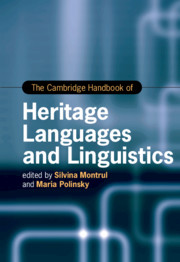Book contents
- The Cambridge Handbook of Heritage Languages and Linguistics
- Cambridge Handbooks In Language And Linguistics
- The Cambridge Handbook of Heritage Languages and Linguistics
- Copyright page
- Dedication
- Contents
- Figures and Tables
- Contributors
- Acknowledgments
- Introduction
- Part I Heritage Languages around the World
- 1 Slavic Heritage Languages around the Globe
- 2 Heritage Languages in Europe
- 3 Heritage Languages in Southeastern Europe
- 4 Heritage Languages in China
- 5 Heritage Languages in Japan and Korea
- 6 Heritage Languages in Israel
- 7 Heritage Languages in Aotearoa New Zealand and Australia
- 8 Heritage Languages in Canada
- 9 Asian Heritage Languages in the United States
- 10 The Vitality of Spanish as a Heritage Language in the United States
- 11 Germanic Heritage Varieties in the Americas
- 12 Arabic in North America
- 13 Heritage Languages in South America
- 14 Language Attrition and Heritage Language Reversal in Returnees
- Part II Research Approaches to Heritage Languages
- Part III Grammatical Aspects of Heritage Languages
- Part IV Heritage Language Education
- Index
- References
10 - The Vitality of Spanish as a Heritage Language in the United States
from Part I - Heritage Languages around the World
Published online by Cambridge University Press: 04 November 2021
- The Cambridge Handbook of Heritage Languages and Linguistics
- Cambridge Handbooks In Language And Linguistics
- The Cambridge Handbook of Heritage Languages and Linguistics
- Copyright page
- Dedication
- Contents
- Figures and Tables
- Contributors
- Acknowledgments
- Introduction
- Part I Heritage Languages around the World
- 1 Slavic Heritage Languages around the Globe
- 2 Heritage Languages in Europe
- 3 Heritage Languages in Southeastern Europe
- 4 Heritage Languages in China
- 5 Heritage Languages in Japan and Korea
- 6 Heritage Languages in Israel
- 7 Heritage Languages in Aotearoa New Zealand and Australia
- 8 Heritage Languages in Canada
- 9 Asian Heritage Languages in the United States
- 10 The Vitality of Spanish as a Heritage Language in the United States
- 11 Germanic Heritage Varieties in the Americas
- 12 Arabic in North America
- 13 Heritage Languages in South America
- 14 Language Attrition and Heritage Language Reversal in Returnees
- Part II Research Approaches to Heritage Languages
- Part III Grammatical Aspects of Heritage Languages
- Part IV Heritage Language Education
- Index
- References
Summary
This chapter presents an overview of Spanish as a heritage language, using the framework of Capacity, Opportunity, Desire, to assess the vitality of US Spanish. Special attention is given to the state of Spanish-language education and its role in supporting vitality. Outlining two major directions for future pedagogical work, this chapter explores how the findings of heritage linguistics and the constructs of superdiversity and linguistic contact zones can strengthen the teaching of Spanish to heritage language learners.
Keywords
- Type
- Chapter
- Information
- The Cambridge Handbook of Heritage Languages and Linguistics , pp. 230 - 251Publisher: Cambridge University PressPrint publication year: 2021
References
- 1
- Cited by

